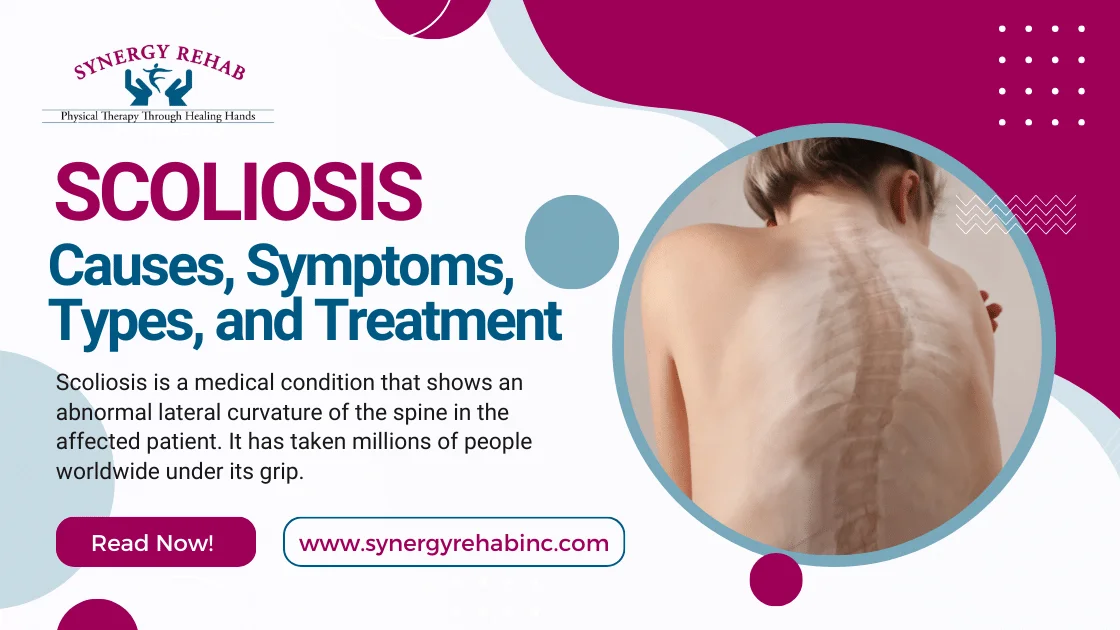
Scoliosis: Causes, Symptoms, Types, and Treatment
Scoliosis is a medical condition that shows an abnormal lateral curvature of the spine in the affected patient. It has taken millions of people worldwide under its grip. It is time to explore the various aspects of scoliosis, focusing on nonsurgical scoliosis treatment options. Let us check the causes, symptoms, types, and effective methods for scoliosis pain relief and curved spine treatment. Do not miss reading this comprehensive guide until the end, as it’s intended to provide valuable insights to patients, caregivers, or people interested in learning more about scoliosis treatment. Understanding Scoliosis Causes of Scoliosis Scoliosis can develop for various reasons, and understanding these causes is important if an effective treatment is to be developed. Symptoms of Scoliosis Scoliosis symptoms are very different from patient to patient, depending on the severity of the curvature and the individual’s age. Common symptoms include: Types of Scoliosis Understanding the different types of scoliosis is crucial for determining the most appropriate treatment plan. Each type of scoliosis affects different regions of the spine and may present unique challenges. Nonsurgical Scoliosis Treatment Nonsurgical scoliosis treatment is often the first line of defence for managing this condition, particularly in mild to moderate cases. The primary objective of these treatments is to reduce pain, improve function, and prevent further curvature progression. Physical Therapy: The Optimal Solution for Scoliosis Treatment Physical therapy has proven to be one of the best nonsurgical treatments for scoliosis. It offers a holistic approach to managing and improving scoliosis symptoms. Unlike other treatments that focus solely on symptom relief, physical therapy addresses the root cause of scoliosis by strengthening the muscles supporting the spine, improving flexibility, and enhancing overall spinal health. This comprehensive approach alleviates pain and helps prevent further curvature progression, making it an essential component of scoliosis treatment and management. Physical Therapy for Back Pain A physical therapist can design a customized exercise program for back pain to strengthen the muscles and reduce the pain caused by scoliosis. Key components of physical therapy for scoliosis include: Bracing Bracing is often recommended for adolescents with scoliosis who are still growing. The goal of bracing is to prevent further curvature progression. Modern braces are more comfortable and less noticeable than older models, improving compliance and effectiveness. Customized Treatment Plans One of physical therapy’s greatest advantages is the ability to create customized treatment plans tailored to each patient’s unique needs. Physical therapists for back pain work closely with patients to assess their condition and develop a personalized exercise regimen. This includes stretching exercises to improve flexibility, strengthening exercises to support the spine, and postural training to correct misalignments. By focusing on each patient’s individual needs, physical therapy ensures the most effective treatment and long-term results for scoliosis pain relief. Evidence-Based Benefits Research consistently supports the benefits of physical therapy for scoliosis. Studies have shown that specific exercise programs can significantly reduce pain and improve spinal alignment in scoliosis patients. For instance, a study published in the Journal of Physical Therapy Science demonstrated that targeted exercises substantially improved pain levels and posture among participants. This evidence highlights the importance of physical therapy as a cornerstone of nonsurgical scoliosis treatment. Preventing Further Progression Physical therapy helps manage current symptoms and also prevents the progression of spinal curvature. Through regular exercise and strength training, patients can maintain a healthier spine, reducing the risk of their condition worsening over time. This proactive approach is especially important for adolescents, who are still growing and may be at higher risk of curve progression. Patients who include physical therapy in their treatment plan can achieve better long-term outcomes and maintain a higher quality of life. Lifestyle Modifications Certain lifestyle changes can significantly impact the effectiveness of scoliosis treatment. These include: Medical Studies and Evidence Several studies have highlighted the effectiveness of nonsurgical treatments for scoliosis. For example, a study published in the Journal of Physical Therapy Science found that manual therapy exercise programs specifically designed for scoliosis patients significantly reduced pain and improved spinal alignment. Another study in Spine Journal emphasized the benefits of bracing in preventing curve progression in adolescents with idiopathic scoliosis. Way Forward Nonsurgical scoliosis treatment offers a range of options for managing this condition effectively. From physical therapy and bracing to lifestyle modifications, patients have numerous tools at their disposal for scoliosis pain relief and curved spine treatment. Understanding the causes, symptoms, and types of scoliosis is crucial in seeking appropriate treatment and achieving the best possible outcomes. If you or a loved one is experiencing symptoms of scoliosis and seeking professional care, consider Synergy Rehab in Southfield, Michigan. Our experienced physical therapists specialize in personalized, nonsurgical scoliosis treatment plans designed to alleviate pain, improve posture, and enhance your quality of life. Book your appointment today and take the first step toward effective scoliosis treatment and management.

Navigating the Holiday Season: Physical Therapy for Auto Accident Injuries
The holiday season in Michigan, a picturesque winter wonderland, brings with it a myriad of traditions and celebrations. It’s a time when the air is filled with the scent of pine, streets are aglow with festive lights, and families gather to share the joy of the season. However, this period also marks an increased risk for auto or holiday accidents, an often-overlooked shadow amid the holiday cheer. The festive season’s charm undoubtedly draws more people onto the roads, whether they are journeying to meet loved ones or bustling through the city’s shopping hubs to find the perfect gifts. This increase in traffic, coupled with the state’s notorious winter weather, lays the groundwork for potential hazards. Michigan’s roads, blanketed in snow and ice, become slippery pathways that challenge even the most cautious of drivers. Additionally, holiday celebrations are synonymous with toasts and cheers, where alcohol often plays a central role. Unfortunately, this can lead to impaired judgment behind the wheel, further escalating the risks of holiday accidents. As we embrace the warmth and joy of the holiday season, it’s crucial to also recognize and prepare for these increased risks, ensuring that the season remains a time of safe and happy memories. Let us highlight the importance of physical therapy in the recovery process for those who suffer auto accident injuries during this busy time. Increased Risks During the Holidays Holiday Traffic With more people on the roads visiting family and shopping for the holidays, traffic congestion increases the likelihood of holiday accidents. Winter Weather in Michigan Snow and ice can make roads treacherous, leading to more frequent collisions. Holiday Celebrations and Impaired Driving Celebrations often involve alcohol, and unfortunately, this can result in impaired driving and holiday accidents. The Role of Physical Therapy Post-Auto Accident or Holiday Accidents Physical therapy is a cornerstone in the rehabilitation process following auto accidents. Its role extends beyond mere recovery; it enhances the quality of life post-injury. Let’s delve deeper into the significant benefits that physical therapy offers in this context: Advanced Pain Management Techniques Physical therapy employs various techniques to manage and alleviate pain. These include manual therapy, such as soft tissue mobilization and joint manipulation, which can release tension and reduce discomfort. Therapists also use modalities like ultrasound or electrical stimulation to target deeper tissues and provide pain relief. Importantly, these methods offer an alternative or complement to medication, potentially reducing reliance on painkillers and their associated side effects. Restoring Mobility and Strength Auto accidents often result in injuries that can limit mobility and strength. The best physical therapist in Southfield uses targeted exercises to rebuild muscle strength, enhance flexibility, and improve overall range of motion. These exercises are tailored to the individual’s specific injuries and recovery goals. Over time, patients can regain pre-accident levels of function and, in some cases, may even surpass their previous physical capabilities. Preventing Long-Term Complications Early and consistent physical therapy can play a critical role in preventing chronic pain conditions. Without proper treatment, auto accident injuries like whiplash or soft tissue damage can evolve into persistent pain or mobility issues. A physical therapist helps actively manage these risks, guiding patients through exercises and treatments that promote healing and reduce the likelihood of long-term damage. Personalized Recovery Plans One of the most significant advantages of physical therapy is its personalized approach. Therapists assess each patient’s unique situation – considering factors like the severity of injuries, lifestyle, and overall health. Based on this assessment, they develop a customized treatment plan for holiday accidents. This plan evolves as the patient progresses, ensuring that the recovery journey is aligned with their individual needs and recovery goals. Physical therapy for auto accident injuries is an invaluable resource for anyone looking to recover effectively. It offers a multifaceted approach to rehabilitation, addressing not just the physical aspects of recovery but also the psychological and emotional components. With the right physical therapy support, patients can navigate the road to recovery with confidence, knowing they have a dedicated professional guiding them every step of the way. Finding the Right Physical Therapist in Michigan Choosing the best physical therapist in Southfield, Michigan, is a critical step in your recovery journey after an auto accident. The right therapist can significantly influence the speed and effectiveness of your healing process. A skilled physical therapist brings a wealth of knowledge and expertise, offering tailored treatment plans that address your specific injuries and personal recovery goals. They can help mitigate pain, restore function, and prevent long-term complications, which are essential for returning to your daily activities. Moreover, a good therapist provides support and guidance, not just physically but also emotionally, helping you navigate the often challenging path to recovery. The rapport you build with your therapist is vital; it fosters a trusting environment where you can work collaboratively towards your rehabilitation goals. Therefore, taking the time to find a therapist who is not only qualified but also a good fit for your individual needs is a crucial step towards a successful and efficient recovery. Licensed Professionals Ensure the physical therapist is licensed and has experience in dealing with auto accident injuries. Personalized Care Look for therapists who provide personalized care and are attentive to your specific recovery needs. Accessibility Consider the location and accessibility of the physical therapy clinic, especially during the harsh Michigan winters, for holiday accident treatment. The holiday season in Michigan poses unique challenges for road safety, leading to an increase in auto accidents. Physical therapy emerges as a vital component in the recovery process for those injured in such incidents. By choosing the right physical therapist, individuals can navigate their recovery effectively and return to their daily lives with renewed strength and mobility. Take Next Step! If you or a loved one has been involved in an auto accident this holiday season and are seeking effective physical therapy, book your consultation with Synergy Rehab in Southfield. Our team of expert physical therapists, often considered the best in Southfield, are committed to providing personalized care tailored


